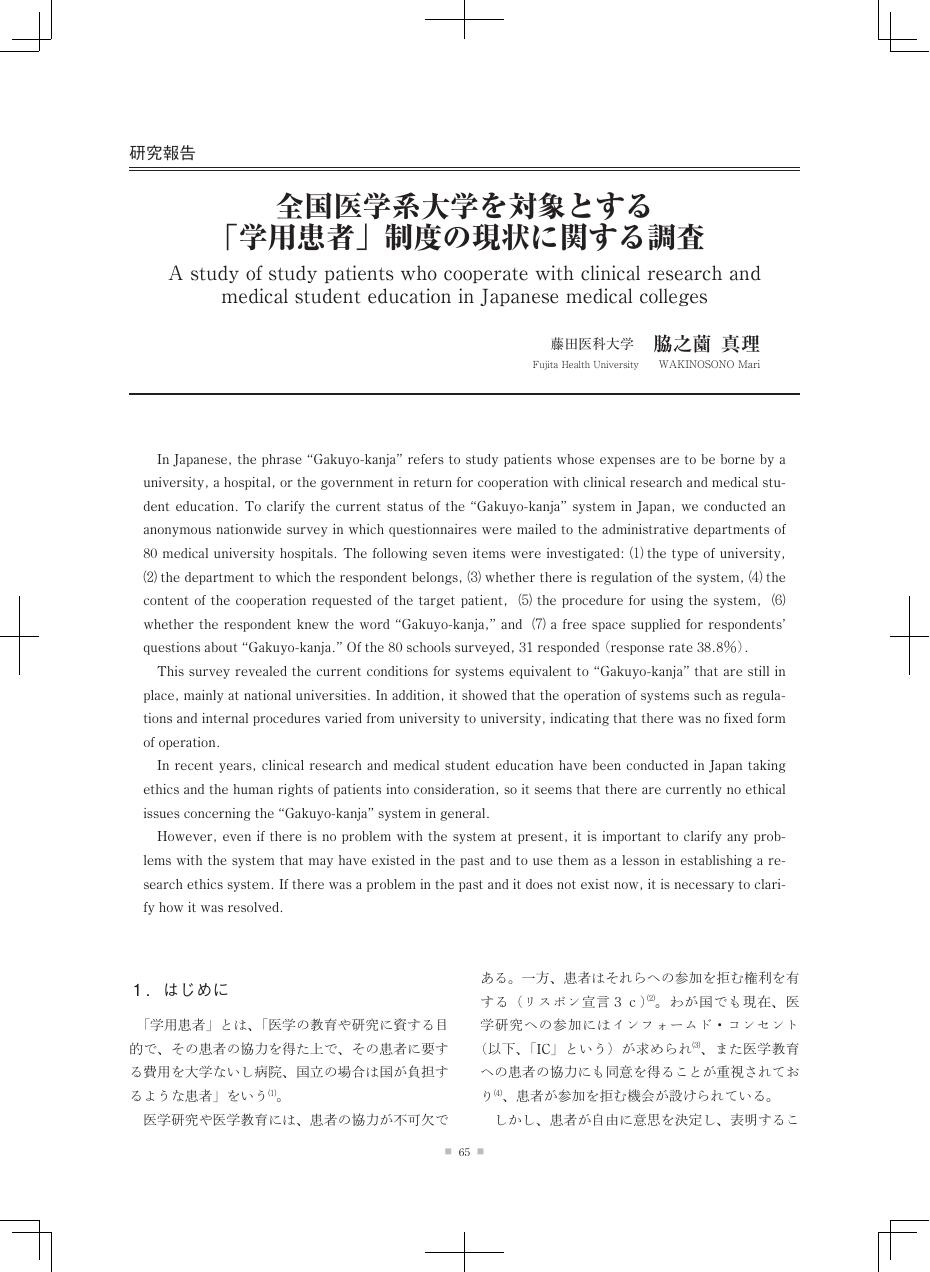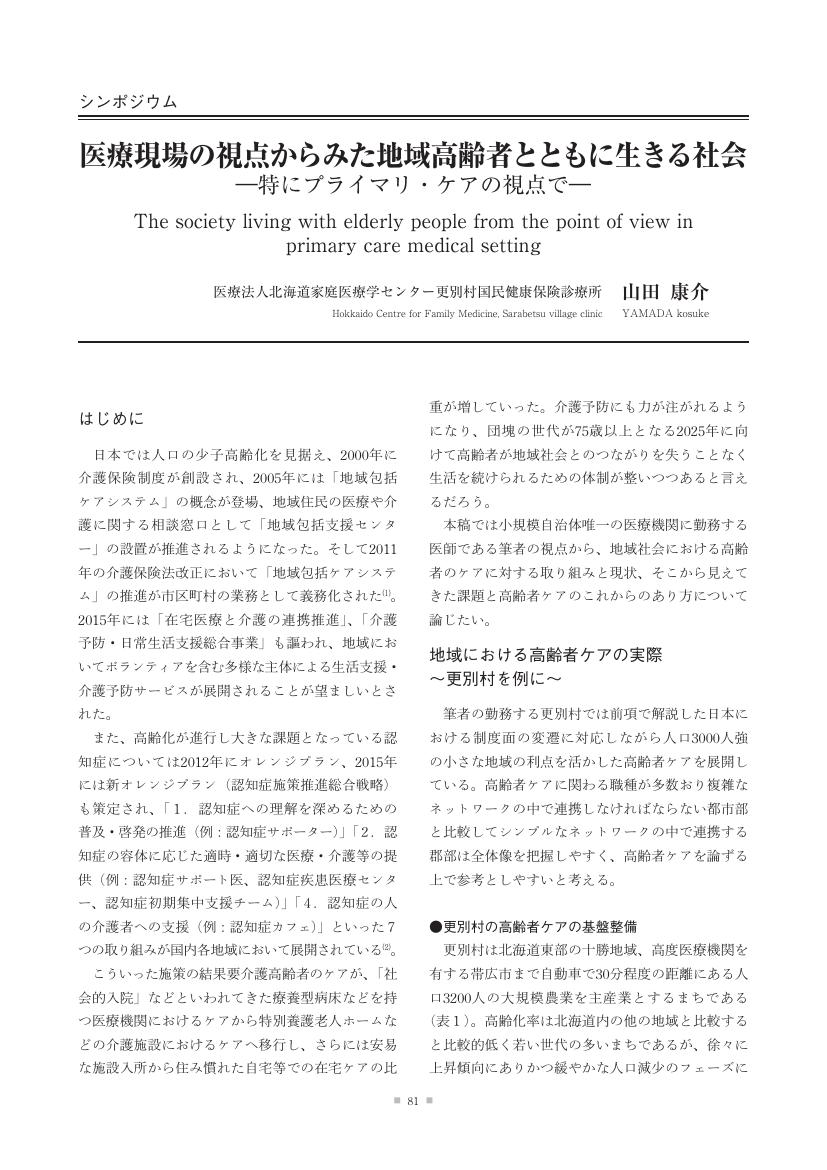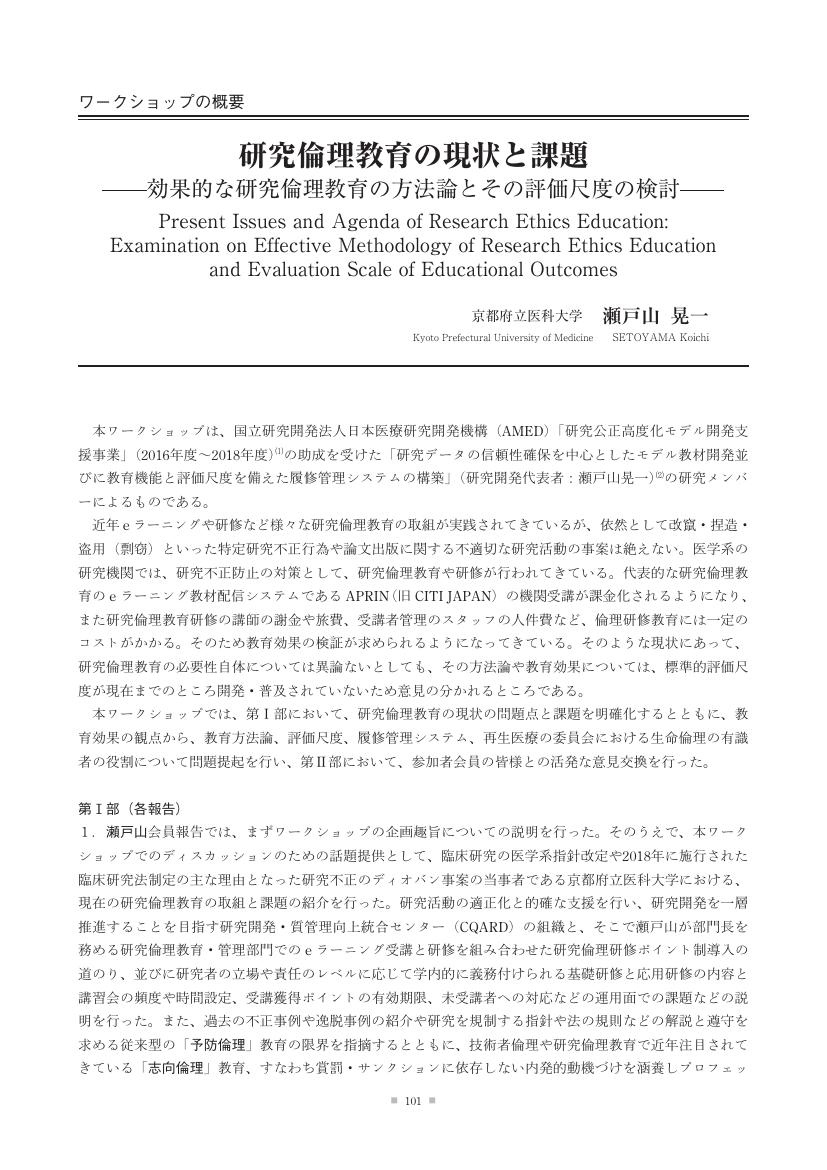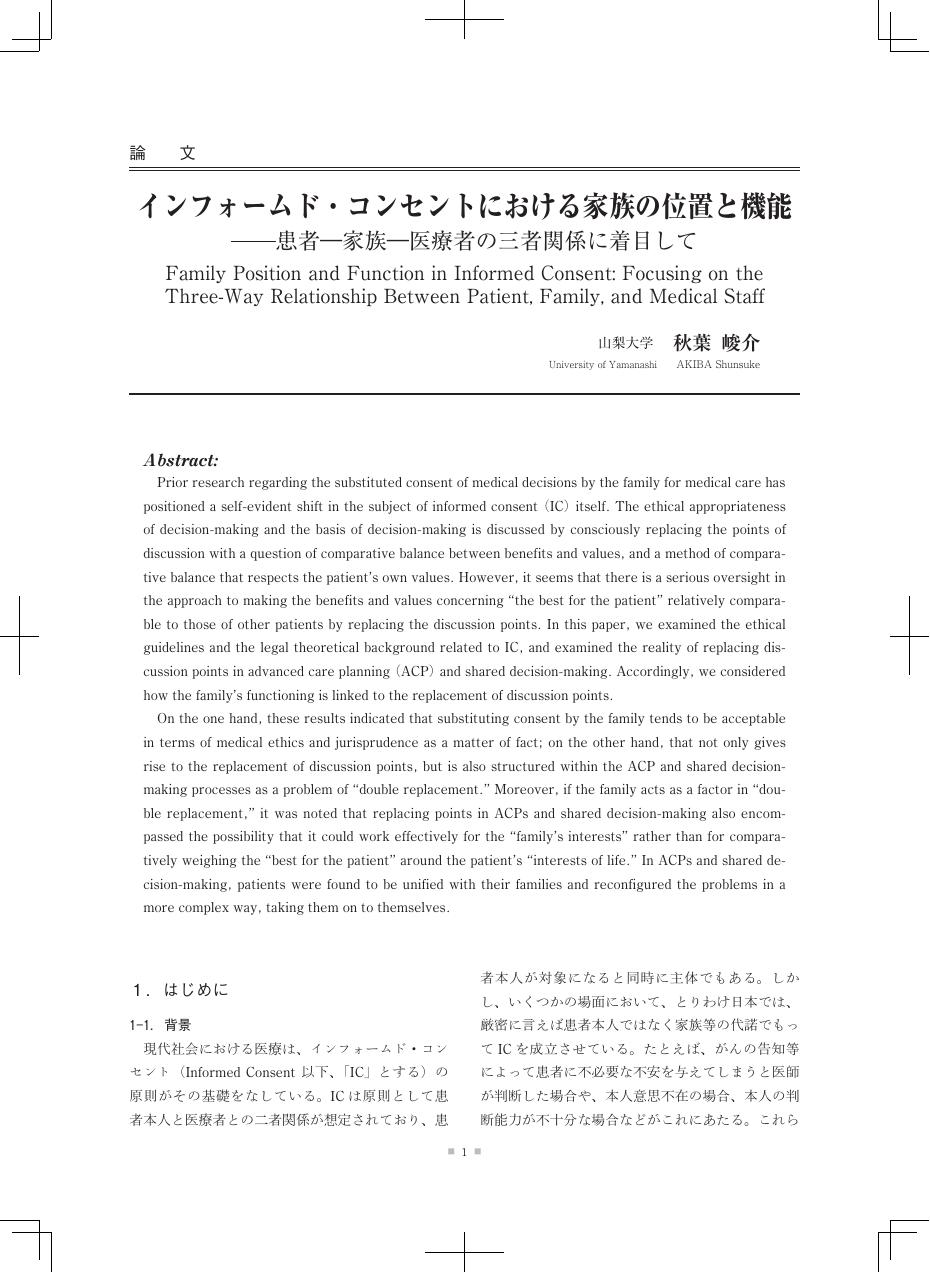2 0 0 0 「かわいそう」という感情をめぐって
- 著者
- 田村 京子
- 出版者
- 日本医学哲学・倫理学会
- 雑誌
- 医学哲学医学倫理 (ISSN:02896427)
- 巻号頁・発行日
- no.17, pp.123-132, 1999-10-01
With regard to the social welfare of disabled persons, I will consider the relationship between feelings of pity for them and discrimination against them. In Japan, most people today who have not been in close contact with disabled persons feel pity for them. Is this feeling of pity an expression of discrimination against them? In this paper, I will describe and analyze the nature of this feeling and make the following points: 1) A feeling is experienced passively, so we cannot modify it at the same time that we are feeling it. Therfore, feelings of pity for disabled persons are not in themselves equivalent to discrimination against them. It is possible to interpret them as such, but this interpretation only presents discrimination as a problem without a solution. 2) Referring to Arbert Memmi's definition of discrimination in context of racism, I will consider the way in which discrimination is the result of a relationship between individuals and society. Discrimination shuld be understood at the social level, namely in its relationship to social structure and social organization. Only then can we find measures to resolve it. 3) Pity for persons with disabilities is no more than a groundless conviction held by non-disabled persons, and is a reflection of the lack of communication between these two groups. 4) We should start from the fact that people, both with and without disabilities live in the same world at the same time, and thus learn to naturally accept heterogeneuty and variety in people.
- 著者
- 丸橋 裕
- 出版者
- 日本医学哲学・倫理学会
- 雑誌
- 医学哲学医学倫理 (ISSN:02896427)
- 巻号頁・発行日
- no.30, pp.40-51, 2012-09-30
Viktor von Weizsacker's significance as an originator of "anthropological medicine" and as a critic of medicine oriented solely to the scientific-biological standpoint encourages us in the present critical situation caused in connection with many problems in medical ethics to seek an adequate paradigm of medical ethics in his works. True, he wrote no systematic ethics of anthropological medicine as such. But his 'Euthanasia' and Experiments on Human Beings (1947) was a salient contribution to the foundation of that field, since in it he asserts that the real, though invisible, defendant on the Nuremberg bench was no particular doctor, but the general spirit of scientific-biological medicine, and declares his guiding principle that the solidarity and mutuality of doctor and patient should guide medical practice. Therefore, in this article I intend to describe the origin of the medical ethics inherent in Weizsacker's "Medical Anthropology" (Medizinische Anthropologie) where he formulates the concepts of solidarity and mutuality. First I try to show clearly how he proves, with the help of the principle of solidarity, that there was no "as such justification" for the 'euthanasia' and human experiments Nazi doctors had put into practice, and further how he tested, in every morally doubtful case, whether it complied with the law of mutuality. Secondly I will clarify in what kind of context medical practice must occur under the law of solidarity, if one is taking the law of mutuality seriously in the association between doctor and patient. And thirdly after showing that the concept of "the solidarity of death" tends to reduce various aspects of the personal and social structure of death to an abstract common denominator, I will consider the meaning of Weizsacker's utterance that the order of life is a fusion of "the solidarity of death" and "the mutuality of life."
2 0 0 0 野口整体の史的変容 : 近現代日本伝統医学の倫理生成過程
- 著者
- 田野尻 哲郎
- 出版者
- 日本医学哲学・倫理学会
- 雑誌
- 医学哲学医学倫理 (ISSN:02896427)
- 巻号頁・発行日
- no.27, pp.1-12, 2009-10-01
Modern Japanese traditional medicine established in the mid-18th century suffered devastating damage due to the execution of the Medical Law (established in 1873) as an integral part Japan's modernization policies. Today, Japanese traditional medicine is a counterculture community on the periphery of modern mainstream medicine, whose practice changes in accordance with social changes. As a traditional medical movement, it has unique ethics that are constantly evolving. The traditional medical movement of a physical technique, which is known as "Noguchi-Seitai" and whose system and theory were established in 1927, passed through two transformation stages, one in 1956 and the other one in 1968. The movement become a community emerging concomitantly with medical techniques continuously alternating between a host and a guest, and the medical practice based on the psychosomatic transformations arose from self-training by the medical practitioner and the patient. Those transformations and generations are revealed from the conceptual viewpoint of "Education as Transformation" (Richard Katz, 1981).
- 著者
- 石田 安実
- 出版者
- 日本医学哲学・倫理学会
- 雑誌
- 医学哲学 医学倫理 (ISSN:02896427)
- 巻号頁・発行日
- vol.39, pp.11-21, 2022 (Released:2022-08-12)
1 0 0 0 OA 選択的人工妊娠中絶の道徳的評価 受容という親の徳の観点からの考察
- 著者
- 川﨑 優
- 出版者
- 日本医学哲学・倫理学会
- 雑誌
- 医学哲学 医学倫理 (ISSN:02896427)
- 巻号頁・発行日
- vol.39, pp.22-32, 2022 (Released:2022-08-12)
- 著者
- 小林 道太郎 坂井 志織
- 出版者
- 日本医学哲学・倫理学会
- 雑誌
- 医学哲学 医学倫理 (ISSN:02896427)
- 巻号頁・発行日
- vol.39, pp.54-64, 2022 (Released:2022-08-12)
1 0 0 0 OA 新潟水俣病事件における妊娠規制の問題:優生思想とフェミニスト倫理学の観点からの検討
- 著者
- 佐藤 靜
- 出版者
- 日本医学哲学・倫理学会
- 雑誌
- 医学哲学 医学倫理 (ISSN:02896427)
- 巻号頁・発行日
- vol.38, pp.11-19, 2020 (Released:2022-07-20)
- 著者
- 中井 祐一郎 比名 朋子
- 出版者
- 日本医学哲学・倫理学会
- 雑誌
- 医学哲学 医学倫理 (ISSN:02896427)
- 巻号頁・発行日
- vol.38, pp.48-56, 2020 (Released:2022-07-20)
1 0 0 0 OA 全国医学系大学を対象とする「学用患者」制度の現状に関する調査
- 著者
- 脇之薗 真理
- 出版者
- 日本医学哲学・倫理学会
- 雑誌
- 医学哲学 医学倫理 (ISSN:02896427)
- 巻号頁・発行日
- vol.38, pp.65-72, 2020 (Released:2022-07-20)
1 0 0 0 OA Advance Care Planning における共同意思決定の理論構造の検討
- 著者
- 秋葉 峻介
- 出版者
- 日本医学哲学・倫理学会
- 雑誌
- 医学哲学 医学倫理 (ISSN:02896427)
- 巻号頁・発行日
- vol.39, pp.1-10, 2022 (Released:2022-08-12)
- 著者
- 中井 祐一郎 比名 朋子
- 出版者
- 日本医学哲学・倫理学会
- 雑誌
- 医学哲学 医学倫理 (ISSN:02896427)
- 巻号頁・発行日
- vol.37, pp.70-77, 2019 (Released:2022-07-20)
1 0 0 0 OA 地域高齢者とともに生きる社会―身体と心を支え合うために―
- 著者
- 船木 祝 小山 千加代
- 出版者
- 日本医学哲学・倫理学会
- 雑誌
- 医学哲学 医学倫理 (ISSN:02896427)
- 巻号頁・発行日
- vol.37, pp.78-80, 2019 (Released:2022-07-20)
1 0 0 0 OA 医療現場の視点からみた地域高齢者とともに生きる社会―特にプライマリ・ケアの視点で―
- 著者
- 山田 康介
- 出版者
- 日本医学哲学・倫理学会
- 雑誌
- 医学哲学 医学倫理 (ISSN:02896427)
- 巻号頁・発行日
- vol.37, pp.81-85, 2019 (Released:2022-07-20)
- 著者
- 秋山 正子
- 出版者
- 日本医学哲学・倫理学会
- 雑誌
- 医学哲学 医学倫理 (ISSN:02896427)
- 巻号頁・発行日
- vol.37, pp.86-89, 2019 (Released:2022-07-20)
1 0 0 0 OA 高齢期の生活を支える制度と課題
- 著者
- 橋爪 幸代
- 出版者
- 日本医学哲学・倫理学会
- 雑誌
- 医学哲学 医学倫理 (ISSN:02896427)
- 巻号頁・発行日
- vol.37, pp.90-94, 2019 (Released:2022-07-20)
1 0 0 0 OA 高齢者の社会参加と地域社会の幸福度―フレイル予防の倫理学的考察―
- 著者
- 宮島 光志
- 出版者
- 日本医学哲学・倫理学会
- 雑誌
- 医学哲学 医学倫理 (ISSN:02896427)
- 巻号頁・発行日
- vol.37, pp.95-100, 2019 (Released:2022-07-20)
1 0 0 0 OA 研究倫理教育の現状と課題 -効果的な研究倫理教育の方法論とその評価尺度の検討-
- 著者
- 瀬戸山 晃一
- 出版者
- 日本医学哲学・倫理学会
- 雑誌
- 医学哲学 医学倫理 (ISSN:02896427)
- 巻号頁・発行日
- vol.37, pp.101-104, 2019 (Released:2022-07-20)
- 著者
- 秋葉 峻介
- 出版者
- 日本医学哲学・倫理学会
- 雑誌
- 医学哲学 医学倫理 (ISSN:02896427)
- 巻号頁・発行日
- vol.38, pp.1-10, 2020 (Released:2022-07-20)
1 0 0 0 OA 尊い生から尊い死へ―1995年から現在までの介護実践を通じて―
- 著者
- 川口 有美子
- 出版者
- 日本医学哲学・倫理学会
- 雑誌
- 医学哲学 医学倫理 (ISSN:02896427)
- 巻号頁・発行日
- vol.36, pp.96-100, 2018 (Released:2022-07-20)
1 0 0 0 OA 「自律」の新たな「弱い実質的説明」ー「正常さ」概念の検討を通して
- 著者
- 石田 安実
- 出版者
- 日本医学哲学・倫理学会
- 雑誌
- 医学哲学 医学倫理 (ISSN:02896427)
- 巻号頁・発行日
- vol.37, pp.1-13, 2019 (Released:2022-07-20)
















